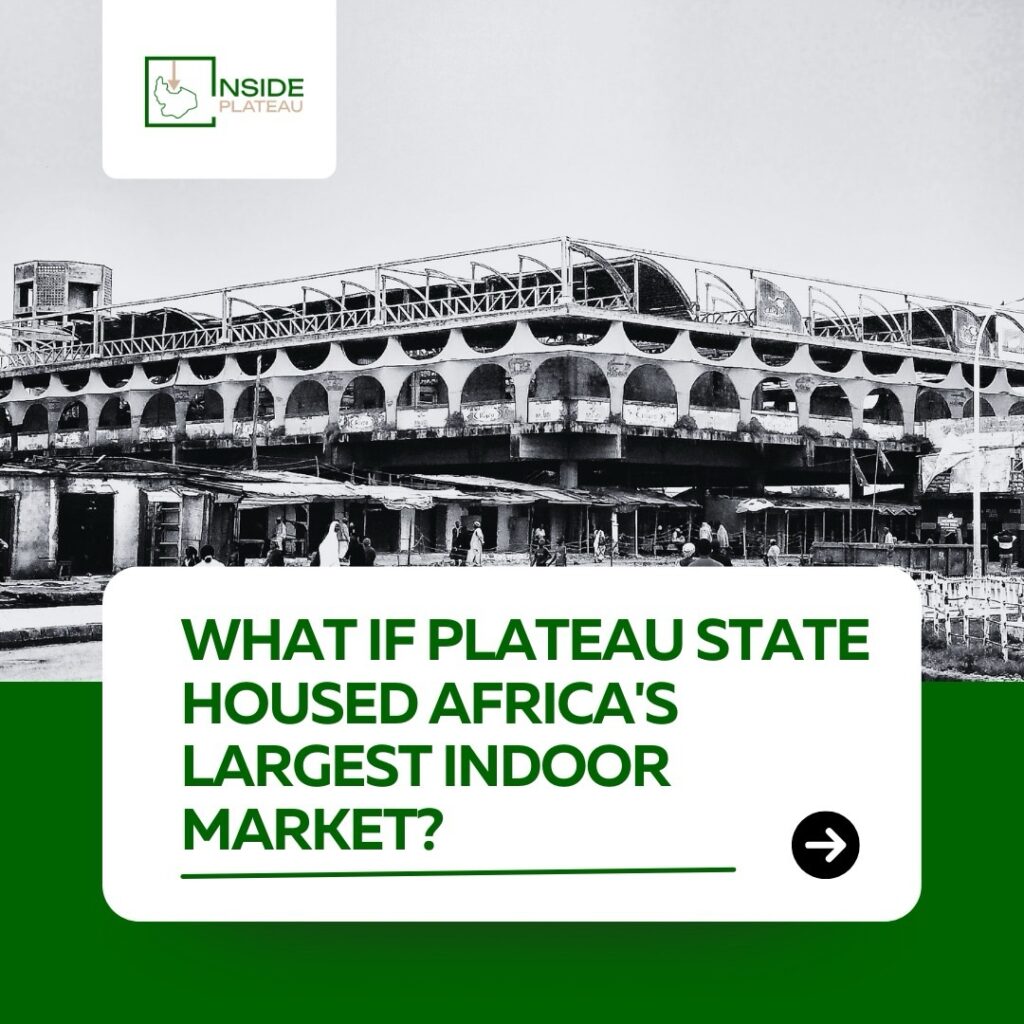Imagine a city with the largest indoor market in Africa at its core. Imagine not just shops, but a world under one roof: rows upon rows of stalls, banks and offices, restaurants and warehouses, a whole economy humming in one place. Imagine tourists flying in, not just for the crisp Plateau weather or the majestic rocks, but to shop, to trade, to marvel. Imagine Jos, not as a sleepy city on the hill, but as the beating heart of African commerce. Imagine the name “Terminus” being spoken in the same breath as “Dubai Mall” or “Kumasi Central.”
Now stop imagining. Plateau actually had all of this.
The Terminus Market that would have Been
Once upon a time, Jos had more than just a market. It had an architectural masterpiece. The Jos Main Market (better known as the Terminus Market) was the largest indoor market in Africa, the pride of Plateau, the jewel of its capital. Conceived in the 1970s by Joseph Gomwalk and completed under Solomon Lar, it was commissioned in 1985 by General Muhammadu Buhari. More than concrete and steel, it was vision made visible. For years, it thrummed with life: traders and buyers, locals and visitors, deals struck, laughter exchanged, and livelihoods secured. Plateau State was not just surviving on tin mining and tourism; it was building a future in trade and commerce.
But the fire of 2002 brought it all down. By the morning after, a dream that had taken more than a decade to build was reduced to charred ruins. For twenty years now, the skeleton of the market has stood as both a memory and a metaphor—an echo of what could have been.
When Jos Took Its Trade to the Streets
What the fire left behind was not just silence, but a scramble. Thousands of displaced traders spilled into the arteries of Jos; roadsides, roundabouts, and residential corners turning into makeshift stalls. The city adapted, but at a cost: endless gridlocks, rising rents, and a market that no longer had a centre, only fragments scattered across the city.
And yet, this sprawl is not unique to Jos. Across West Africa, some of the most famous markets thrive without walls or roofs. Lagos has Balogun, a maze where fabric, fashion, and fortune jostle for space. Kumasi boasts Kejetia, a market so sprawling it is often described as a city within a city. Even Computer Village in Ikeja (chaotic, crowded, yet indispensable) proves that open-air trading can become a global hub for commerce and innovation.
By accident, Jos now belongs to this family of open-air giants. But unlike Kumasi or Balogun, Terminus was never meant to be a survival story. It was designed to be a leap. A move from the everyday hustle of trading on the streets to the grandeur of an ultramodern complex. That is why the ruins sting so sharply: Plateau wasn’t just building a market; it was building a statement.
While Dubai Ran, Plateau Paused
When people talk about global icons of commerce, Dubai Mall almost always slips into the conversation. It flung its doors open on November 4, 2008, not too long ago if you think about it. Back then, Dubai itself was still in the middle of rebranding from a desert stopover to the capital of the world’s ambitions. The mall was its crown jewel: over 1,200 shops, an indoor aquarium with sharks gliding above your head, an ice rink in the middle of the desert, cinemas, restaurants, fountains, and foot traffic in the tens of millions, every single year. Today, it’s not just a shopping centre but practically a country of its own.
However, here’s the twist: Plateau had been nursing a similar fire decades earlier. Jos wasn’t trying to build just another market where traders hustled from sunrise to dusk. It was sketching something bigger: an indoor complex that would change the skyline, redefine commerce, and turn a city into a statement. In spirit, Jos was already thinking global while Dubai was still sketching outlines in the sand.
So, when we look at Dubai Mall today, it’s not envy that should rise in our throats but recognition. Recognition that Plateau wasn’t dreaming out of place. That its ambition to move from open stalls to an indoor giant wasn’t a fantasy, but the same playbook other nations have used to announce themselves to the world.
The tragedy isn’t that the dream was too bold. The tragedy is that we let the fire stop the story halfway. Because if Dubai could start from sand dunes and end up with a wonder of the world, then Plateau (rock-solid and already halfway there) has no business shrinking its vision.
Standing Under the Ruins
Walk under the skeleton of Terminus and you’ll see it: life refusing to die. Traders have carved out stalls with wood, tarpaulin, and stubborn hope. Between concrete pillars, aisles snake with everything from clothing to phone chargers, cosmetics and more; a patchwork of colour under a broken roof. It’s rough, but it breathes.
And here’s the thing: even in this half-born form, there’s beauty. The shade under the ruins adds an extra cool to a Jos afternoon in ways the street never can. For a moment, you catch a glimpse of what was once promised: comfort, order, a marketplace built for dignity.
But let’s be honest, this is not the finish line. It’s the trailer of a bigger film. The danger is getting too used to it, letting “good enough” bury the dream. Because if a leaking roof and makeshift stalls can still pulse with so much life, imagine what a complex could unlock: jobs that last, streets that flow, a city centre that finally feels whole again.
This isn’t an ending. It’s scaffolding. The only real question is: do we settle for the preview, or do we bring the full picture back to life?
A Future Waiting to Happen
So, what if Jos Main Market had not burned down? Plateau might today be a hub of commerce, a destination for investors, a jewel in Nigeria’s crown. But dwelling on what was lost is not enough. The better question is: what if Plateau dares to dream like that again?
Because the dream did not die with Gomwalk, or with the fire, or with the bombs. The dream was bigger than one man, bigger than one building. It was a dream of Plateau as a place where imagination translates into reality, where ambition builds monuments, where people gather not just to buy and sell, but to belong to something larger.
We don’t need to rebuild Terminus exactly as it was. But we need to recapture its spirit. We need to believe that Plateau can produce something bold, something new, something the world must come to see.
A Call to Imagination
Next time you walk past the ruins of Terminus, don’t just see broken walls and wasted years. See the market alive again. See the traders standing proudly in their stalls, the buyers streaming through clean aisles, the city pulsing with life. See Plateau as it could be.
Because this is not just about one market. It is about a culture of daring, of believing that Plateau deserves greatness, and of refusing to let our best ideas die in ashes.
So, what if Jos Main Market had not burned down? The real question is what if Plateau dares to dream like that once more?

